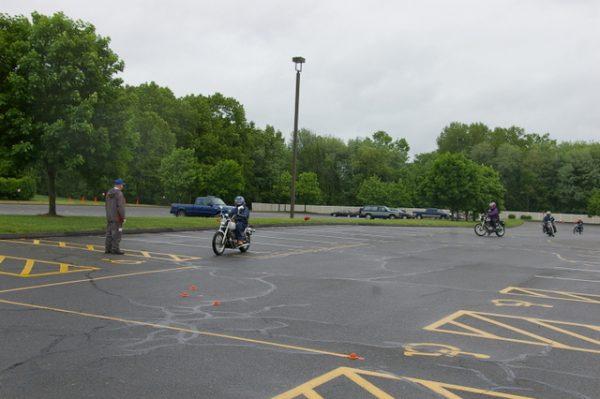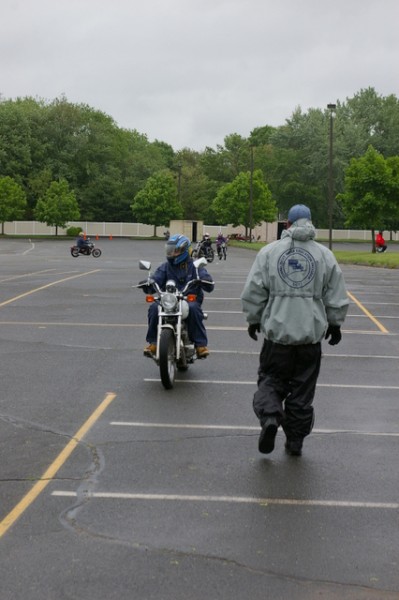Several years ago during introductions in a beginning rider course a student mentioned that he was hoping to learn how to lay a  bike down to avoid a crash. My response was “Laying down the bike IS crashing!!”
bike down to avoid a crash. My response was “Laying down the bike IS crashing!!”
When a rider states they deliberately laid down a bike to avoid crashing into something it may
be an indication that the rider’s physical and mental skills need improvement. The root cause is often improper swerving or [maximum] braking technique – two very important crash avoidance skills.
If they are new techniques to you, they may be skills best learned in a rider education course. I’ll take a brief look at these two skills, and then bring a guest contribution on total stopping distance from Larry Buck; a friend and rider coach from Boca Raton, FL.
Swerving is probably the most effective maneuver for a quick response to avoid a hazard. The net effect is to put the motorcycle in a position to go around the hazard while remaining on the general path of travel. A swerve is two short aggressive counter-steer turns, the first to avoid the hazard and the second to get back on the path of travel. During a swerve the rider’s body position should be independent from the motorcycle and upright. No brakes should be used during the swerving process as most available traction is used by the swerve process.
Maximum braking is typically defined as full application of both brakes without locking either wheel. The front brake provides the bulk of the braking power. Maximum braking is accomplished by using a firm, progressive squeeze of the front brake lever. This allows proportional weight shift to the front tire to maintain adequate traction while braking. Rear brake usage may be lessened as weigh shifts off the rear wheel.
Let’s take a look at how the mental skills of good situational awareness and visual perception ties into good overall braking. The concept of total braking distance is not new. The remainder of this article comes from my guest contributor Larry Buck…
“Total stopping distance is comprised of three components – Perception Distance, Reaction Distance, and Braking Distance.
“Perception distance is how far you travel before you become aware of a hazard. The higher your speed, the more distance you travel while you perceive situations.
“Reaction distance is the distance traveled from the time you become aware of a hazard until you apply the brakes – higher speeds equal more distance traveled.
“Braking distance is the distance you travel after applying the brakes; higher speed equals more distance required to stop the bike. As an example, a typical total stopping distance from 60 MPH is 300 feet or more. Stated another way – a football field.
“You may have read that a motorcycle can stop in 150 feet from 60 MPH. How does that number relate to YOUR braking skills? The answer for most of us is very little. Remember that distance was done by a highly skilled rider, one who does quick stops every day.
“Do you do or practice quick stops every day? When the time comes when you need to stop – have to stop NOW, could you do it? Chances are probably not. Why? Because most riders do not practice doing quick stops, so when we really need to, things may not work out well.
“How often do you take some time to self-assess, and hone your braking skills? We all strive for the perfect line through a curve, a smooth shift, or a tight U-turn, but probably do not put the same effort into practicing stops in shorter distances.
“Knowing the above information, which of the 3 components of total stopping distance (perception, reaction, braking) do you think is most important? We can pretty much eliminate Reaction Distance because everyone reacts in approximately the same amount of time: one second. So that leaves the other two components; perception distance and braking distance. Of those two, which one do you think is more important?
“Let’s assume that professional’s 150 foot stopping distance equals a 10/10. The sooner you perceive a hazard, you may not need a 10/10’s stop, maybe only a 9/10’s or 7/10’s stop. One of the ways to focus attention while riding is to play a “What If” scenario like an endless loop tape through your mind. By doing something similar, you will be perceiving situations sooner. This will provide you with space, and a strategy of how you will deal with the situation if required. Perception skills (your eyes and mind) will enable you to respond smoothly, instead of needing to instantly react.”
 Ride CT & Ride New England Serving New England, NYC and The Hudson Valley!
Ride CT & Ride New England Serving New England, NYC and The Hudson Valley!




